When you’re headed out to go snowshoeing, skiing or hiking, make sure you have your layers lined up, especially mid-layers. Not sure what classifies as a mid-layer? No sweat. Think of them as the centerpiece of your cold- or cool-weather outfit. They’re made to keep you warm (but not too warm) when you’re outside, and are the best way to customize your layering system for all types of conditions.
When you’re choosing mid-layers, here are the basics:
-
What is a mid-layer? Learn how a mid-layer fits into your outdoor layering system.
-
Why are mid-layers important? See why they’re so key for cold weather activities.
-
What material is best? Fleece, merino wool, down or synthetic insulation each have pros and cons.
-
Weather conditions and activities: Considerations for temperatures and what you’ll be doing.
So, what exactly is a mid-layer?
A great day outside starts with a solid layering system made of a base layer, mid-layer and outer layer.
Start with a base layer, a.k.a. the layer closest to your skin, to wick moisture and add warmth. Before you add on your outer or shell layer (such as a rain jacket or winter parka), that’s where the mid-layer comes in. Mid-layers act as an insulating buffer between your base and outer layers, trapping body heat and moving moisture outwards. They come in a variety of materials and designs – vests, hoodies, zip-ups and more.
When you’re choosing mid-layers, think about features you’d like. Do you need a hood, or do you already have a hood built into your shell? What about pockets to keep your hands warm if you forget your gloves? There are plenty of other features to consider too, from elastic hems that seal out wind to underarm zippers that let you vent heat.
Why are mid-layers important?
Mid-layers are a key addition to any cold-weather outfit or when you’re dealing with sudden changes in weather. They can keep you warm with very little weight, and you can take them off and easily store them away in your bag if things start getting a little too hot. A good mid-layer is also breathable to keep moisture moving through your layering system.
Mid-layers are also great for shoulder season or when winter starts to melt into spring, since they can act as a standalone jacket – you can leave your bulky parka behind and still have light, flexible warmth. Look for mid-layers with DWR (durable water repellent) treatment if you plan to use it without a shell to shed light moisture.
Mid-layer materials
Mid-layers cover a pretty large selection of apparel, and it may seem a bit overwhelming on which material to choose. Many are made of fleece, merino wool, down or synthetic insulation, and each material has its own unique benefits.
Fleece
Fuzzy fleece is popular due to its ultra-soft touch. But don’t let its softness fool you – this material is both durable and breathable, so you stay warm without getting overheated. It’s often a more affordable option, and many fleece jackets use recycled polyester (which transforms plastic bottles into a plush, cozy material).
Pros: Soft, durable, breathable, stays warm while damp, and quick to dry.
Cons: Not recommended for wet, windy weather, as it’s not water-resistant and wind moves right through it. Not as compressible as down or synthetic insulation, so it takes up a bit more space in your pack.
Good for: Cold temps during activities like snowshoeing or simply playing in the snow.
Merino wool
Stretchy merino wool can absorb up to 35% of moisture and helps you stay cozy thanks to its warmth-to-weight ratio. Merino comes in different fabric weights – the higher the number, the thicker and warmer the wool. Many MEC Label merino wool layers use wool sourced with the Responsible Wool Standard. A merino-synthetic blend is generally more durable than full merino wool layers.
Pros: Wicks sweat, regulates temperature and is naturally odour-resistant, which means less washing required.
Cons: Heavier than other mid-layers (when you consider a warmth-to-weight ratio), and more expensive if you’re looking for affordability.
Best for: Cold-weather activities where you work up a sweat, like cross-country skiing, or if you’re going days without laundry on multi-day trips.
Down insulation
Down is measured by fill-power, which helps indicate the quality of the down plumage. The higher the number, the higher the insulation and loftiness of the clothing. A higher fill-power means less down needed for the same warmth rating (not to be confused with down weight, which is how much down is used).
The down in MEC Label jackets is sourced with the Responsible Down Standard. Since down requires a bit more care when washing, make sure you properly know how to clean your down jacket to make it last.
Pros: Lightweight with plenty of heat retention. Compresses super small to pack away if you get too warm.
Cons: Rainy weather can make down clump and lose its warmth factor.
Best for: Cold, dry days and laid back outdoor fun, like chilly morning walks and winter camping, plus cold belays and hut trips.
Synthetic insulation
Synthetic insulated materials are typically made of polyester, with the fibres forming a fabric that traps heat inside (just like down does) to keep you warm. As a sustainable bonus: MEC uses recycled content to make material that is just as strong as non-recycled polyester.
Pros: Retains warmth when wet and is more cost-efficient than down.
Cons: Doesn’t compress quite as small as down.
Best for: Camping, cold morning runs, backcountry skiing or climbing.
Consider weather and activities
Before you choose your mid-layers, first think about what activity you’re wanting to tackle outside. Aiming for a big snowshoe trek on cold mountain trails? Or looking for a laidback day of spring skiing? The mid-layers you choose will depend on factors like the temperature, whether you’re facing rain or snow, and what kind of physical output you’ll be putting in.

